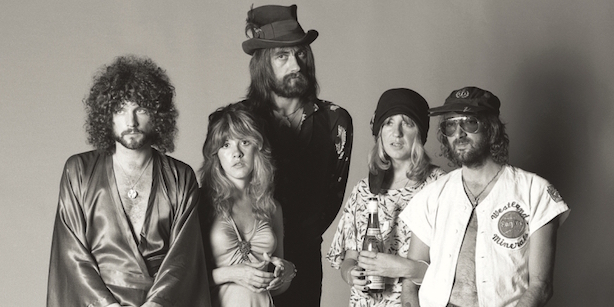 Music
Music
5 albums with incredible backstories
by Rob Rousseau
January 22, 2016
These albums' amazing origin stories have become musical legends.
Is there any job that sounds like an easier, more fun-filled good time than recording an album? Spending time with your buddies, partying, jamming, collaborating, and producing something that could possibly be enjoyed by millions around the world?
However, when you throw together a bunch of insecure narcissists trying to find that sweet spot between art and commerce, boatloads of drugs and alcohol, corporate record labels just trying to make a buck, the dual expectations of diverse legions of fans and pretentious music critics, it’s really a wonder any records get made at all. This potent mix for drama ensures that every album has at least one interesting story behind it. Some of these stories pass into legend.
Fleetwood Mac – Rumours
Awkward encounters with your ex are never fun. You’re trying to leave the past behind and move on with your life, maybe you’re testing the waters with someone new to see where it leads, and then boom, you stroll into a fun-sounding house party/bar/concert/bowling alley/D&D session and there they are. Evening ruined. Is there anything more awkward?
Why yes, there is: having to work with your ex. Then there’s no escaping it, day in day out, you’re forced to interact with someone who has caused you nothing but heartbreak, pain and anxiety, sometimes you even have to work together on a project, setting aside the still-simmering personal drama to pull together for a common goal. Is there any possible scenario where that kind of terrible work environment could lead to something positive?
Apparently there is at least one, as Fleetwood Mac proved in 1976, navigating some serious emotional landslides created by the shifting interpersonal dynamics of the group to produce one of the greatest rock albums of all time. When they went into the Record Plant in Sausalito, California to record Rumours, keyboardist/vocalist Christine McVie and bassist John McVie were freshly divorced after being married for eight years. Vocalist Stevie Nicks and guitarist/vocalist Lindsey Buckingham were in the midst of a tumultuous, on and off again relationship that, over the course of the recording, skewed more towards the off-again category.
Those insane interpersonal dynamics were complemented by some of the music business’s most legendary debauchery as the band took advantage of a virtually unlimited budget to enjoy copious amounts of the various drugs widely available in the Bay Area in the mid-70s. Together, all these factors are pretty much the perfect recipe for guaranteed, unmitigated disaster.
It is a borderline miracle the band survived those sessions. That they actually managed to finish recording something that was fit to be sold is a genuine miracle. That they managed to produce a stone-cold classic of an album like Rumours is definitive, tangible proof of the existence of a rock ‘n’ roll Jesus.
The Beach Boys – Smile
Life in 1965 was pretty good for Brian Wilson. His decision to retire from touring professionally with the Beach Boys to focus solely on songwriting and recording had resulted in their classic album Pet Sounds, leading them to newfound critical and artistic success. Wilson said he wanted the follow-up to sound like “a teenage symphony to God,” and after installing a sandbox in his living room (as one does) and recruiting eccentric lyricist Van Dyke Parks as collaborator, work on the album began in earnest.
These inauspicious beginnings led to one of the music industry’s most notorious debacles as months began to pass, recording costs piled up and Wilson became less productive and increasingly unstable. As he descended further into drug addiction and paranoia, production ground to a halt and was eventually cancelled altogether. Some of the songs from the Smile sessions were reworked into the album Smiley Smile but Wilson’s inability to ever fully realize his initial artistic vision represented a personal and professional failing to Wilson that haunted him for decades.
Smile remained essentially the Moby Dick of lost rock ‘n’ roll albums until Wilson, reinvigorated after his long struggle with mental health and personal demons, returned to work on the album with Parks and musician Darian Sahanaja, finally releasing Brian Wilson Presents Smile to widespread critical acclaim in 2004, 37 years after work had begun.
Bruce Springsteen – Nebraska
The Boss’s acoustic, introspective exploration of the dark side of the American dream was initially conceived as a rocking affair in the vein of the previous releases that had elevated him to stardom in the ’70s. In an effort to streamline the somewhat chaotic studio process and keep recording costs down, Springsteen decided to write and record demo versions of each song by himself before beginning the formal studio process. He completed the demos at his home using a simple four-track recorder and sparse instrumentation in early 1982.
As planned, he then went into the studio with the E Street Band and developed full band versions of each song, but once the album was finished, Springsteen and producer Jon Landau preferred the haunting folk elements of the demo tapes and ultimately opted to release them instead.
Nebraska is really one of those magical musical stories; an improbable collision of seemingly innocuous decisions that culminated in an accidental masterpiece, almost as if it willed itself into existence out of the ether, through the power of the spirit of America.
Neil Young – Homegrown
Neil Young is just one of those artists with such an insanely massive, incredibly diverse discography, that it’s not a matter of whether he’s got some incredible album backstories but determining which one stands out above the others.
That distinction should probably go to Young’s legendary, unreleased 1975 album Homegrown, which has tantalized obsessive Neil fans for decades by both its complete lack of availability (it has, shockingly, never leaked or circulated as a bootleg) and how Young himself has talked about the album, describing it as “the missing link between Harvest, Comes a Time, Old Ways, and Harvest Moon.”
The main factor that gives Homegrown the edge over other Neil Young albums in the backstory department is the insanely casual way that Young decided he would not be releasing it. As Neil tells it, the album was in the can and he had several friends over for a listening party. After imbibing in unknown quantities of illicit substances (“we were out of our minds” is how Young described it), they listened to the album. Afterwards they had a listen to another album of his that he had randomly decided not to release, Tonight’s The Night, which just happened to be on the same reel.
Judging by the subtle differences in vibe during the two different albums, by the time the evening was over he had decided to release Tonight’s The Night instead, relegating Homegrown to the infamous lost album dustbin. Considering how difficult and arduous it can be to write and record an album, there’s something both insane and also kind of impressive about someone going through all the effort to do it, up to and including commissioning album art, and then just saying, “Nah, I’m good,” when said album harshed a few mellows at a house party.
Guns ‘N’ Roses – Chinese Democracy
The sordid backstory to this album is a tragic tale of the out of control hubris of an obsessive perfectionist who chased an elusive rock ‘n’ roll dragon all the way to career irrelevance.
The key difference between Smile’s 39 years between the beginning of production and album release and Chinese Democracy’s relatively paltry 10-or-so years is that Smile was abandoned for decades before work finally resumed, while Chinese Democracy was in production, in one form or another, for that entire period, racking up a completely ludicrous $13,000,000 in production costs in the process. That’s a lot of american flag underpants.
Much of the band’s tumultuous implosion was detailed in Slash’s excellent autobiography, but by the mid ’90s, every original member of the band besides Axl had either been fired or resigned, leaving Rose free to pursue whatever creative direction he desired.
Unfortunately, not even he seemed to know what that was, as rumours swirled about the potential new G n’ R sound, with Axl giving sometimes completely contradictory quotes about what exactly was going on. Members, contributors and producers came and went faster than anyone could keep track of them. The album kept getting delayed. Multiple firm release dates were postponed, until Geffen completely pulled it from their release schedule in 2005.
Chinese Democracy had, by that time, become an industry joke and was widely assumed that it would probably never be released, until in 2008, it finally was. And the ending is perhaps the most tragic part of the Chinese Democracy odyssey, as the finished product wasn’t a masterpiece, it wasn’t a trainwreck, it was simply, painfully average. Where Appetite For Destruction felt improvisational and electric, the result of five men grabbing an invisible livewire and channeling a sordid rock n’ roll id into half an hour of perfection, Chinese Democracy was overthought, overproduced, overwritten and was met largely with indifference. But it don’t really matter.





